

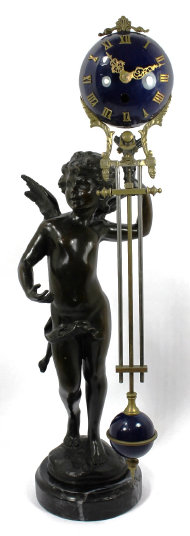
322. $200
French swinger on Moreau’s Cupid. This is a bronze or bronze-coated statue of Auguste Moreau’s
sculpture of Cupid. In other examples the boy is holding an arrow in his right hand and the left hand is holding a bow; here
the left the hand holds the mount for the ball and pendulum clock. The 15.5-inch statue and marble base are in excellent shape
with no damage or wear, making me think they are not old (1970’s?); however, the movement inside the ball looks quite a bit older
than that and has had some repairs. The clock and pendulum are also in very nice shape. The clock is running, but not
robustly. Nothing other than the statue is signed. With the clock mounted it stands 19.5 inches high. Includes a
key. $250-$450.

323. $200
Ansonia “Peer” crystal regulator, ca. 1914. This 12-inch tall crystal regulator has a bright
gold finish, beveled glasses all around, jeweled pallets, and a signed porcelain dial with one small fracture at the right winding
arbor. There is a fancy standing gong and the original 2-jar pendulum, more ornate than found on many other models. Signed
movement is running, striking on the half-hour and counting the hours. No recent Antique Clocks Price Guide sales but one in
similar condition sold on eBay last winter for $355. $350-$500.
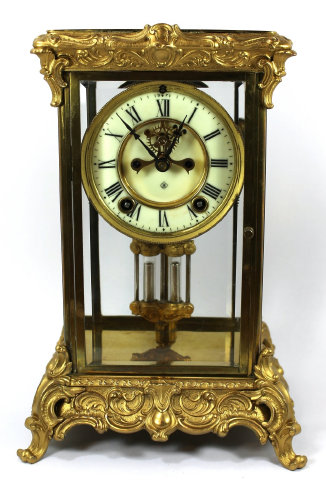
324. $250
Pickard & Punant French figural, ca. 1860. This French figural clock stands just 12 inches
tall on a gilt bronze base with alabaster inserts. The girl is playing a tambourine with a music stand and several horns next
to her, cast in a rich bronze finish. The clock has a porcelain dial, no glass or bezel. There are two very faint hairlines
in the dial, too faint to show in our photo. Original French Breguet hands. The movement is signed and strikes the bell
on the half-hour and counts the hours. It is running and keeping time. $500-$1000.
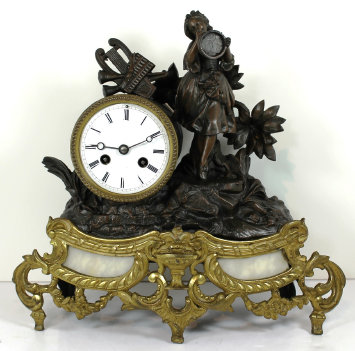
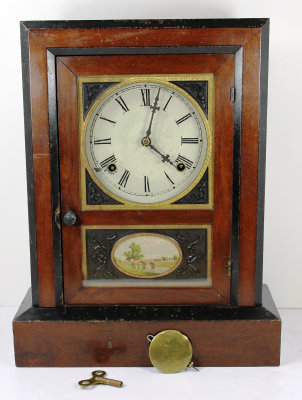
325. $75
Jerome & Co. cottage, ca. 1875. The patent date of 1870 on the door label dates this clock
to after purchase of the company by the New Haven Clock Co. The mahogany-veneered clock is just under 16 inches tall with black
painted trim all around. Some wear is evident, especially around the door latch. There is what appears to be a burn mark
on the top surface, but it doesn’t detract significantly. The metal dial retains most of the original paint and is relatively
clean; the hands are appropriate but do not quite match. The gutta percha inserts with gold trim are in good shape, no cracks,
with a typical idyllic country picture. The interior retains the original wallpaper. The 8-day time-and-strike unsigned
movement is running and striking a wire gong. A nice example of this model. $100-$200.
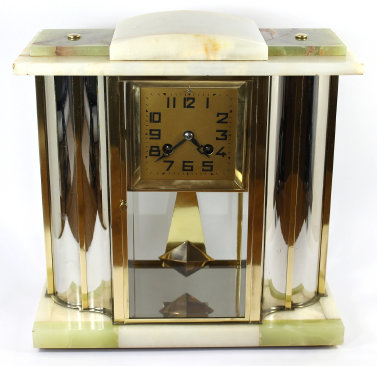
326. $300
French Art Deco onyx clock, ca. 1920. This beautiful archetypal art deco clock is 12.5 inches
tall and 12.25 inches wide, with a white onyx base and top and green onyx accents in front and on top. Can’t you just see Fred
Astaire and Ginger Rogers dancing around a room that looked like this clock? Beveled glasses all around, bright brass framing
with two curved metal mirrors on either side (forming an ogee curve), and a fancy brass diamond-shaped pendulum. The onyx is
clean and crack-free. The metal dial is rather dark but I think it was designed that way, as it does not show uneven oxidation,
wear, or soiling. The pendule de Paris movement (signed Marti) has an outside count wheel and strikes a bell on the hour and
half-hour. The strike arm needs a bit of adjustment to properly strike the bell; the movement and pendulum have matching numbers. The clock is running and striking on cue. $500-$1000.
327. $1000
Ithaca “Index”, ca. 1875. There are several versions of the “Index”, this being the most common. They differ in the top piece. The walnut case is 31.5 inches high, clean and unmarred. There are carved incisings on the
door and dial boards. The calendar dial indicates that it was made for Lynch Brothers, who I believe were clock
retailers; the time dial is new. The glass is original but the Index lettering is worn. The unsigned 8-day movement is
running, keeping time, striking the hours on a large nickel bell, and the calendar is advancing. Three sales over the last 3
years on eBay averaging $1700; Schmitt’s sold a very similar condition model in 2011 for $2300. $1200-$1500.